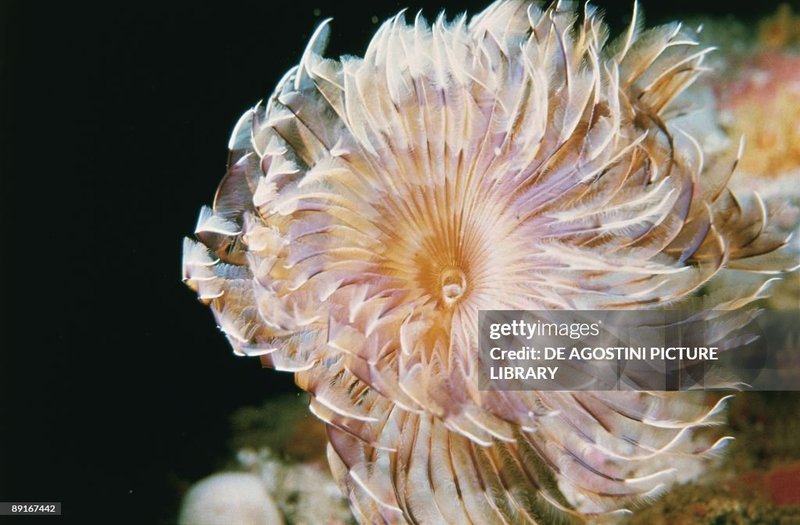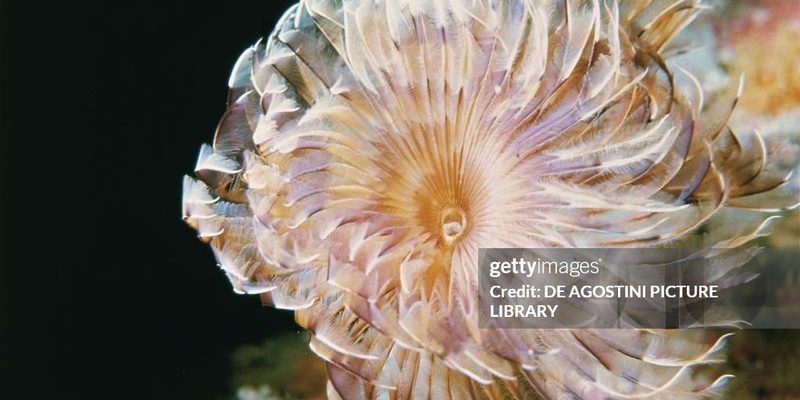
Now, you might be wondering where to find these enchanting creatures. The truth is, sabellid fan worms can be found in oceans all around the globe, from warm tropical waters to colder temperate regions. Their range and distribution is much more extensive than you might think. In this article, I’ll take you on a journey through their habitats, helping you understand where and how these fascinating worms thrive.
What Are Sabellid Fan Worms?
Before diving into their range and distribution, let’s break down what exactly sabellid fan worms are. These marine creatures belong to the family Sabellidae and are characterized by their long, slender bodies and beautiful, elaborate fan-shaped crowns made of tentacles. These fans serve two main purposes—they help the worm feed and provide a stunning visual display for divers and underwater photographers.
Sabellid fan worms are polychaetes, a class of annelid worms, which means they have segmented bodies. The fan-shaped structure, called a crown, is not just for show. It helps the worm filter food from the water, catching tiny plankton with the delicate tentacles. The worms can retract their fans into their protective tubes made of mud, sand, and other materials—a clever way to hide from predators.
Here’s the thing: these worms are not just solitary creatures. They often form colonies, which can create beautiful underwater gardens. This means when you spot one, there’s a good chance you’ll see several others nearby, all living together in harmony.
Global Distribution of Sabellid Fan Worms
Sabellid fan worms have a remarkable distribution across the world’s oceans. You can find them in a variety of marine environments, from shallow coastal waters to deeper offshore areas. They thrive in both warm waters, like those in the Caribbean, and cooler regions, such as those found along the coast of Europe.
Their versatility means they can adapt to different habitats, which is partly why they’re so widespread. They enjoy environments with stable sediments, as their tubes provide protection. This adaptability makes them resilient, allowing them to occupy various ecological niches.
Some regions, like the Mediterranean Sea, are particularly rich in species diversity, hosting numerous types of sabellid fan worms. In contrast, you’ll find fewer species in less hospitable environments, such as the deep, dark ocean trenches.
Habitat Preferences and Conditions
So, what kind of habitats do sabellid fan worms prefer? Generally, they are very much at home in soft sedimentary environments, which are rich in organic material. Here are some key points about their habitat preferences:
- Soft substrates: They thrive in sandy, silty, and muddy bottoms which allows them to construct their protective tubes effectively.
- Reefs: You’ll spot many of them around coral reefs, where they can find ample food and shelter.
- Intertidal zones: Some species can be found in tidal pools, adapting to the changing conditions of the tide.
- Estuaries: They are often present in estuaries where freshwater meets saltwater, as these regions are nutrient-rich.
By understanding these habitat preferences, researchers can better predict where to find specific species of sabellid fan worms. It also highlights the importance of preserving these habitats, as they host not just worms but entire ecosystems.
Species Diversity and Distribution
When talking about sabellid fan worms, diversity is key. There are several species, each with unique traits and preferred habitats. For example, the Eudistylia vancouveri, commonly known as the Pacific fan worm, is found along the North American west coast. In contrast, the Sabella spallanzanii is prevalent in the Mediterranean region.
Each species has adapted to its local environment, which means they exhibit varying degrees of tolerance to water temperature, salinity, and sediment type. You might find that some species are more abundant in certain areas due to local conditions or specific ecological roles they fulfill.
The way these worms spread out geographically can also tell us a lot about ocean currents and how they affect marine life. For instance, larvae from sabellid fan worms can drift for considerable distances before settling down to form a new colony. This helps to explain their widespread distribution.
Importance of Sabellid Fan Worms in Marine Ecosystems
You may be surprised to learn just how vital sabellid fan worms are to marine ecosystems. Their fan-shaped crowns not only feed the worms but also play a crucial role in filtering water, which can improve water quality in their habitats. This filtering action helps maintain a balanced ecosystem that supports other marine life.
Moreover, the tubes they build serve as shelters for various small organisms, creating a microhabitat within the larger marine environment. Think of it like an underwater apartment complex—many small creatures can find refuge and food near these fan worms, contributing to local biodiversity.
Additionally, scientists are studying these worms to understand how environmental changes (like pollution and climate change) impact marine ecosystems. By monitoring their populations and health, researchers can gauge the overall health of ocean environments.
Conservation and Threats to Their Habitats
Despite their hardiness, sabellid fan worms face threats due to human activities and environmental changes. Overfishing, pollution, and habitat destruction are major concerns. When coastal areas are developed or polluted, the delicate balance that allows these worms and other marine life to thrive can be disturbed.
Here are a few key threats to consider:
- Pollution: Runoff from land can introduce harmful chemicals and nutrients into the water, affecting the health of sabellid fan worms.
- Habitat destruction: Coastal development and dredging can destroy the soft substrates they need to thrive.
- Climate change: Rising sea temperatures and ocean acidification can alter the conditions necessary for their survival.
Conservation efforts are essential to protect these creatures and their habitats. Fostering awareness is a great first step; understanding why these worms matter can inspire more people to advocate for ocean conservation.
How to Appreciate Sabellid Fan Worms
Now that you know more about sabellid fan worms and their importance, you might be wondering how you can appreciate them. If you’re a snorkeler or diver, keep an eye out for their beautiful fan structures during your underwater adventures. Respect their habitats by avoiding touching or disturbing them.
You can also support marine conservation organizations that work to protect fragile ecosystems. Educating yourself and others about these incredible creatures can help raise awareness about the importance of preserving marine life. By spreading the word, you contribute to larger conservation efforts aimed at protecting the ocean’s diversity.
In summary, the documented range and distribution of sabellid fan worms highlight not only their adaptability but also their significance in marine ecosystems. By understanding where they thrive and the challenges they face, we can work towards a healthier ocean for all its inhabitants. Let’s cherish these unique creatures and their habitats, ensuring they continue to flourish in our oceans for generations to come.

